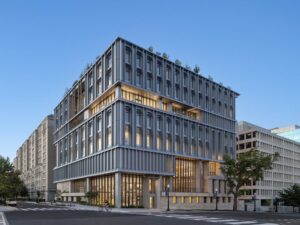- 8 Mart 2017
- 3822 defa okundu.
Katılımcı, Bandırma Tasarım Parkı Yarışması
Mimari Açıklama Raporu (İngilizce):
A Future Habitat Recall: Bandırma Urban Park
This Recall of a Habitat for the future finds its existence on Bandırma Urban Park, i.e., given competition site. The project dwells upon the idea of maintaining the existing urban and natural contexts and architectural heritage, and integrating new proposal to Bandırma urban culture. The project takes Bandırma as one of the major cultural, industrial, and touristic towns of Turkey that is conceptually and functionally located at the very dynamic junction of two seas, i.e., Agean and Marmara. The new park proposal represents the most public assets of Bandırma, such as green, social, educative, technological, and recreational, on one hand and offers new accommodation types via four and five star self-sufficient hotels, and commercial models in more urban, humane, and natural environments.
Conceptual Agenda of a Habitat Recall
Nature and Culture are two crucial notions of the Urban Park to appreciate and to sustain existing assets and contextual qualities, such as migrant birds’ pools, port(s), dense vegetation, military barrack and watch tower ruins, inherited circulation patterns, directional nodes, and to make it more resilient for changing conditions. The project site is considered as the catalyst or rather as the generator of new urban functions that are strategically planned for Bandırma. Some design concepts are the essentials of the future habitat project: mobility; accessibility; flexibility; balance; extension; variety; and connectivity.
There are certain term couples metaphorically and architecturally considered and designed via Bandırma Urban Park, by (re)claiming meaning of a habitat, i.e., the port and the station; art and industry; design and technology; and birds and winds.
Routes and Gates of Panormos
The main scheme of the project, as in site plan, is derived from the directions, edges, and thresholds of the site. The History Route is symbolized by the Biological Bridge coming from the Ancient City / Archaeological Site, climbing towards the Ancient Gate on the south-east direction, and being completed by the Main Alley of the Urban Park. Sea Route refers to İstanbul and Panormos – the Old Protected Port and is completed by the New Port as the northern gate at the west. The major axis connecting the City of Bandırma to Erdek and to the west is called City Route or Route 10, and major entrance of the Urban Park with the funicular system, the tram station, and management units is the Urban Gate, welcoming Bandırma to the Activity Corridor of the Park.
Chains of Nature
Natural heritage of Balıkesir in general, Bandırma in particular is totally protected by means of flora and fauna. The natural cycles existing on the site are retained by using topography for designing multiple layers of the Urban Park, by thematic gardens of Balıkesir flora and endemic plants of the region, by designing birds’ pools, preserving rural landscape and wetlands, and nests on the bird migration routes, and considering seasonal changes for new park design. For instance, on the northern edge of the site wind curtains, covered by thin film in order not to harm birds, are proposed to minimize climatic effects. All trees and major shrub spots existed on the site are kept as they are, and green texture is expanded towards Bandırma by means of plant corridors, wooded areas, and wetlands.
Recycling and waste management are also crucial issues to be considered for production – consumption chain of the Bandırma Urban Park. Particularly rain water collection and reusing containers, and solid waste recycling units are designed in the Urban Park.
Multi-Functionality and Architectonics of Urban Park
The overall scheme of the proposal is dwelt upon the idea of nature – culture interaction. Particularly The major axis of the proposal, running along northwest and southeast directions, the Main Alley, carries basically main transportation modes, and new urban functions. The Design Bazaar runs parallel to the Alley and holds it at the south by its linearity and transparency, respecting surrounding historical, registered buildings. The preserved and restored military buildings as if they are fingers of the park towards the Marmara Sea, and linear landscape elements on the south as natural lanes of the rural landscape heritage complete each other. The existing buildings are renovated as retail shops and commercial units, and new steel-glass structural annexes as art galleries. The Bazaar creates a green illusion, by its glazed façade surfaces, translucent roof cover, reflecting all surrounding plantation in front, at the back, and on both sides. The Design Bazaar and other commercial units, in the form of open, semi-closed, and closed spaces, include several design functions, and serve for furniture, jewellery, textile, handicraft, accessories, housewares, and cuisine workshops revealing ancient regional heritage.
Five-star Hotel, resembling ancient healing tradition and spirit of Panderma, is designed as a Remedial Hotel and located at the northern end of the site as an independent entity by all functions of integrated wellness, i.e., detox centre, medical healing, weight loss, chiropractic treatment, and a sports club. A well-tailored spa is proposed to offer ‘urban cure’ for Bandırma people and visitors, programs like osteopathy, psychology, nutrition, life coaching, and naturopathy.
The north-south direction is particularly emphasized by the mega but carved, solid but flexible, closed but extraverted, mono-block architecture including the Design Institute, the Four-star Hotel, and the Convention Centre. This mono-block is called as the Living Wall of the Bandırma Urban Park, a new interpretation of a wall in an extreme transparent and flexible way. The ground level of the block, Design Institute, serves totally for the public. Since the intention is to preserve natural aspects as they are and integrating architecture to them, keeping trees here, there are huge holes in and on the mass open to the sky. Open accessibility and dynamism brings a new free space. Flowing soft and hard landscape, a multi-purpose open-air theatre, a bookstore, and park administration are the major functions. These new design and learning spaces, scheduled festivals and ceremonies, cuisine ateliers and services will bring a future for Bandırma. The Hotel principally serves for students, researchers, academicians, and their families based on the accommodation model of living – producing – experiencing together. Different than conventional four-star hotels this Student Hotel has play areas, a performance stage, study rooms, lounges, and sports areas. The Hotel is bridged to the Design Institute. The Convention Centre is connected to the five-star Remedial Hotel and the Design Institute with its sea-viewed terrace to be used as the main foyer.
There are several car parking areas throughout the Urban Park and the only open-air one is at the southeast, between the Ancient Route and the Route 10. Other closed and underground car parking have three entrances, serving to Remedial and Student Hotels, Design Institute, and the Convention Centre, and are connected to the main system via the Main Alley.
A Challenging Design Wind: Time and Space Sequences
The main park square with its public inner courtyard, funicular system, The Tower, techno-market, GSM core, and whole-food and farmers’ market operates as the hub of Bandırma Urban Park bonding two major lines or rather spines of the proposal, i.e., the Main Alley and the Activity Corridor. There is a peculiar ring that is called as LOOP 60 (holding the contour line 60), carrying all existing and revitalized watch towers of the Site as vertical dots, for facilities and refreshments, e.g., newspaper seller, fresh juice box, snack bar, souvenirs, small kitchenette.
The Biological Bridge represents one of the ecological and living forms of the park via transporting green between the park and Bandırma as in the master plan, and connecting future habitat to the past, the Ancient City.
There is an Open-air Sculpture Garden at the northwest end of military ruins that are turned into a museum, cafes, and workshops. That Open-air Garden will host sculptures for years produced by several sculptors in time as if it is a museum.






